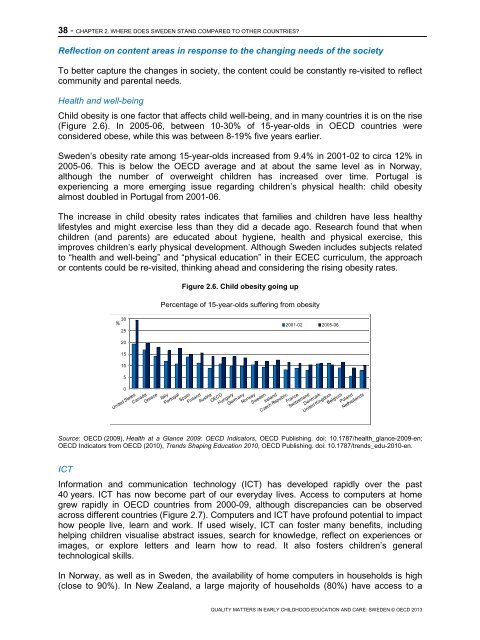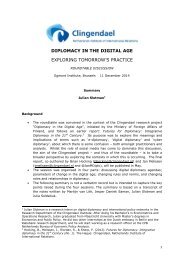SWEDEN%20policy%20profile%20-%20published%2005-02-2013
SWEDEN%20policy%20profile%20-%20published%2005-02-2013
SWEDEN%20policy%20profile%20-%20published%2005-02-2013
Create successful ePaper yourself
Turn your PDF publications into a flip-book with our unique Google optimized e-Paper software.
38 - CHAPTER 2. WHERE DOES SWEDEN STAND COMPARED TO OTHER COUNTRIES?<br />
Reflection on content areas in response to the changing needs of the society<br />
To better capture the changes in society, the content could be constantly re-visited to reflect<br />
community and parental needs.<br />
Health and well-being<br />
Child obesity is one factor that affects child well-being, and in many countries it is on the rise<br />
(Figure 2.6). In 2005-06, between 10-30% of 15-year-olds in OECD countries were<br />
considered obese, while this was between 8-19% five years earlier.<br />
Sweden’s obesity rate among 15-year-olds increased from 9.4% in 2001-<strong>02</strong> to circa 12% in<br />
2005-06. This is below the OECD average and at about the same level as in Norway,<br />
although the number of overweight children has increased over time. Portugal is<br />
experiencing a more emerging issue regarding children’s physical health: child obesity<br />
almost doubled in Portugal from 2001-06.<br />
The increase in child obesity rates indicates that families and children have less healthy<br />
lifestyles and might exercise less than they did a decade ago. Research found that when<br />
children (and parents) are educated about hygiene, health and physical exercise, this<br />
improves children’s early physical development. Although Sweden includes subjects related<br />
to “health and well-being” and “physical education” in their ECEC curriculum, the approach<br />
or contents could be re-visited, thinking ahead and considering the rising obesity rates.<br />
30<br />
%<br />
25<br />
20<br />
15<br />
10<br />
5<br />
0<br />
Figure 2.6. Child obesity going up<br />
Percentage of 15-year-olds suffering from obesity<br />
2001-<strong>02</strong> 2005-06<br />
Source: OECD (2009), Health at a Glance 2009: OECD Indicators, OECD Publishing. doi: 10.1787/health_glance-2009-en;<br />
OECD Indicators from OECD (2010), Trends Shaping Education 2010, OECD Publishing. doi: 10.1787/trends_edu-2010-en.<br />
ICT<br />
Information and communication technology (ICT) has developed rapidly over the past<br />
40 years. ICT has now become part of our everyday lives. Access to computers at home<br />
grew rapidly in OECD countries from 2000-09, although discrepancies can be observed<br />
across different countries (Figure 2.7). Computers and ICT have profound potential to impact<br />
how people live, learn and work. If used wisely, ICT can foster many benefits, including<br />
helping children visualise abstract issues, search for knowledge, reflect on experiences or<br />
images, or explore letters and learn how to read. It also fosters children’s general<br />
technological skills.<br />
In Norway, as well as in Sweden, the availability of home computers in households is high<br />
(close to 90%). In New Zealand, a large majority of households (80%) have access to a<br />
QUALITY MATTERS IN EARLY CHILDHOOD EDUCATION AND CARE: SWEDEN © OECD <strong>2013</strong>








